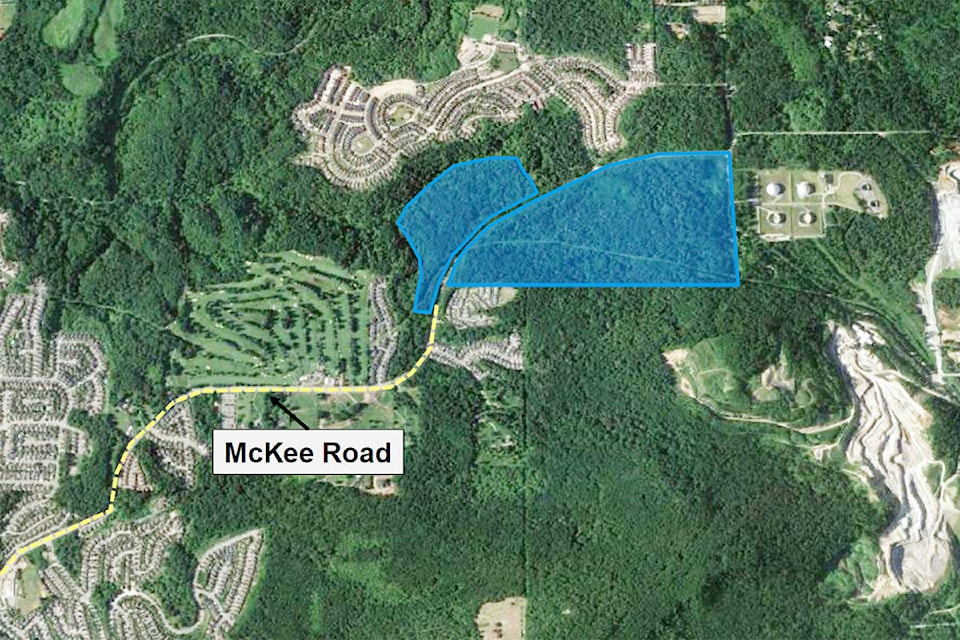As he talks about the Abbotsford Tech District – the rebooted concept of the proposal formerly known as We Town – Gavin Dew says the word “conversations” a lot.
Last fall, Abbotsford’s council voted to exclude the We Town concept from planning for the McKee Peak and Auguston area. That vote was a significant rebuke to Auguston Town Development’s ambitious We Town plan – which would have seen tens of thousands of apartments, and millions of square feet of technology-oriented office space.
In the months following, the company hired Dew, a consultant and lobbyist, to help reboot the idea and find support for it. Hence all those conversations.
The Abbotsford Tech District concept maintains We Town’s goal of creating space for 18,000 technology workers – along with housing for many of those people. But Dew says that other parts of the plan have been effectively “shredded” and rewritten with the input of local stakeholders.
Those groups include the University of the Fraser Valley, with whom the developers have signed a memorandum of understanding, and XLRator, a Fraser Valley business organization focused on fostering the region’s technology industry. Those and other partnerships are hoped to solidify some of the uncertainties that prompted questions when the plan went before city planners.
“We’re getting a ton of buy-in from stakeholders in senior government,” Dew told The News. “What we are contemplating now is an incremental, phased approach.”
The first phase of that approach – the development of an “agritech accelerator” with the UFV as its education partner – is specifically intended to provide an answer to those who would ask “What’s in it for Abbotsford?” Such an accelerator would aim to provide a home for university researchers, agritech businesses and other users.
RELATED: Planning price tag revealed for futuristic ‘We Town’ concept in Abbotsford
RELATED: Developer proclaims ‘relaunch’ of We Town proposal in Abbotsford
To make it happen, the developers say that, along with the land, they’ll provide up to $50 million in capital costs.
“What we tried to do is build a concept that is tied into and bring together a whole lot of disparate conversations that have been happening at the same time around tech in the Fraser Valley and in particular around the potential for agri-tech to be stronger, bigger, better here,” Dew said. “There have been a lot of conversations happening and what we are trying to do is act as a bit of an aggregator to bring those conversations together around a concrete proposal and around some resources that can bring to fruition a lot of conversations that have been ongoing for some time.”
Dew says the accelerator “is intended to be a front-loaded community benefit to ensure that Abbotsford and the Abbotsford taxpayer benefits up front from what we are proposing to do.”
Of course, it’s also a key part of the developers’ own commercial and marketing plan. A key appeal of the Abbotsford Tech District plan, Dew says, lies with the availability of vacant land in a livable and relatively affordable location in fairly close proximity to an already established and quickly growing technology industry.
But that aspect also brings with it the questions and challenges that led to We Town’s rejection last year. Namely: how does launching a huge development with tens of thousands of residents on Abbotsford’s outskirts co-exist with the city’s own lauded plan for centralized cores?
Dew said resolving those issues will require more talking.
“We obviously need to make sure things like servicing and transportation are workable,” he said. “Those are ultimately technical and financial conversations. But they are solvable conversations. Before we’re in a position to solve for those problems, we need to make sure the concept we’re proposing makes sense for the city, makes sense to the city and is something they want to see happen.”
The We Town concept imagined almost all those who worked at the site, living in small apartments. But a consultant hired by the city suggested some of the scenarios were unrealistic, and there was a disconnect between the developer’s plans for where workers at the site would live, and where they might actually choose to reside. And that could require the city to pump money into upgrading roads to accommodate the increased traffic.
Dew said that and other issues have been noted.
“Let’s not kid ourselves, not everybody who works here is going to live in a 500-metre radius of their office,” he said. Dew said there would be a need to increase the capacity of roads in the area, including McKee Road. But he said some of those plans are already on the books, and that there is time to address those challenges, with building at the site envisioned to take place over multiple decades.
But he said that while there may be the need for more infrastructure, some of that could benefit Abbotsford residents across the city. He pointed to the widening of Highway 1 and the possibility of rapid transit to the region. “We’re not the provincial government, but I do think developments like this … help to provide a clear rationale,” he said.”
Do you have something to add to this story, or something else we should report on? Email:
tolsen@abbynews.com
